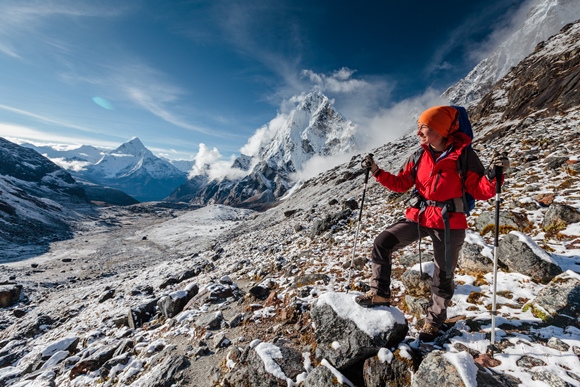Acclimatization is crucial for trekkers on the Annapurna Circuit, ensuring they can safely adapt to the high altitudes encountered along this iconic Himalayan route. This comprehensive guide explores effective strategies to acclimatize properly, enhancing safety, comfort, and overall enjoyment during the trek.
The Annapurna Circuit reaches altitudes exceeding 5,000 meters (16,400 feet) at Thorong La Pass, presenting challenges due to decreased oxygen levels and atmospheric pressure. Altitude sickness, or acute mountain sickness (AMS), can affect anyone ascending too quickly without proper acclimatization. Symptoms range from mild headaches and nausea to more severe conditions like high-altitude pulmonary edema (HAPE) or cerebral edema (HACE), which can be life-threatening if untreated.
Acclimatization involves the body’s gradual adjustment to altitude, allowing it to cope with reduced oxygen levels effectively. Proper acclimatization reduces the risk and severity of AMS, enabling trekkers to enjoy the stunning landscapes and cultural experiences along the Annapurna Circuit safely. The key is ascending slowly, giving the body time to adapt physiologically to higher elevations.
Gradual Ascent: Ascend gradually, aiming for a maximum gain of 300-500 meters (1,000-1,600 feet) in elevation per day once above 3,000 meters (9,800 feet). This pace allows the body to adjust and produce more red blood cells to carry oxygen more efficiently.
Rest Days: Schedule rest days every 3-4 days to allow for further acclimatization. These days involve light activity or short hikes at higher altitudes, aiding adaptation before ascending to higher elevations.
Hydration and Nutrition: Stay hydrated by drinking plenty of fluids, avoiding alcohol and caffeine which can dehydrate the body. Maintain a balanced diet rich in carbohydrates and moderate in protein to support energy levels and recovery.
Sleeping Altitude: Whenever possible, sleep at lower altitudes than the highest point reached during the day’s trek. This strategy helps reduce the physiological stress of higher elevations during rest.
Medication: Consider carrying acetazolamide (Diamox) as a preventive measure against AMS symptoms. Consult with a healthcare provider before using and understand potential side effects.
Monitor personal health and fellow trekkers for symptoms of AMS, including headaches, nausea, dizziness, and fatigue. If symptoms persist or worsen despite preventive measures, descend to a lower altitude immediately. Recognize severe AMS symptoms such as confusion, difficulty breathing, or loss of coordination, which require urgent medical attention.
Acclimatization is fundamental to the safety and enjoyment of trekking the Annapurna Circuit. By understanding altitude effects, implementing gradual ascent strategies, and monitoring personal health, trekkers can minimize the risks of altitude sickness and maximize their experience in Nepal’s breathtaking Himalayan landscapes. Respect local customs, conserve natural resources, and embrace the cultural richness encountered along the route. With proper acclimatization strategies in place, trekkers embark on a transformative journey filled with awe-inspiring views, cultural encounters, and personal achievement amidst the majestic peaks of the Annapurna region.
Introduction to Altitude Acclimatization
Altitude acclimatization refers to the process by which the human body adjusts to decreasing oxygen levels and atmospheric pressure as altitude increases. The Annapurna Circuit, with its highest point at Thorong La Pass (5,416 meters), necessitates effective acclimatization to prevent altitude sickness and ensure a safe trekking experience. Acclimatization involves physiological adaptations such as increased production of red blood cells to improve oxygen transport and changes in breathing patterns to maintain adequate oxygenation. Trekkers must understand and implement acclimatization strategies to enjoy the stunning landscapes and cultural experiences along this challenging Himalayan route.
Understanding Altitude Sickness: Causes, Symptoms, and Severity
Altitude sickness, also known as acute mountain sickness (AMS), results from the body’s inability to acclimatize adequately to high altitudes. Causes include rapid ascent without proper acclimatization, genetic predisposition, and individual susceptibility. Symptoms of AMS range from mild headaches, nausea, and dizziness to more severe conditions such as high-altitude pulmonary edema (HAPE) or cerebral edema (HACE), which can be life-threatening if untreated. Severity depends on altitude reached, rate of ascent, and individual factors like fitness level and hydration status. Recognizing early symptoms, monitoring personal health, and implementing acclimatization strategies are essential for preventing and managing AMS during the Annapurna Circuit trek.
Importance of Acclimatization: Why Proper Adjustment is Crucial
Acclimatization is crucial for trekkers on the Annapurna Circuit to safely adapt to high altitudes and minimize the risk of altitude sickness. Proper adjustment allows the body to physiologically adapt to reduced oxygen levels by increasing respiratory rate, heart rate, and production of red blood cells. This adaptation improves oxygen transport to tissues and organs, supporting physical performance and reducing the severity of AMS symptoms. Trekkers who acclimatize effectively can enjoy the trek with greater comfort and safety, experiencing the natural beauty and cultural richness of the Annapurna region without compromising their health. Understanding the importance of acclimatization encourages trekkers to implement gradual ascent techniques, schedule rest days, and monitor symptoms to optimize adjustment to high altitudes along the Annapurna Circuit.
Gradual Ascent Techniques: Tips for Safe Elevation Gain
Gradual ascent techniques are essential for safe elevation gain and effective acclimatization on the Annapurna Circuit. Begin trekking at a moderate pace, ascending no more than 300-500 meters (1,000-1,600 feet) in elevation per day once above 3,000 meters (9,800 feet). This gradual approach allows the body time to adjust physiologically to reduced oxygen levels and atmospheric pressure. Schedule rest days every 3-4 days to aid acclimatization, engaging in light activity or short hikes at higher altitudes to promote adaptation. Maintain hydration by drinking plenty of fluids and avoiding alcohol and caffeine, which can contribute to dehydration and exacerbate AMS symptoms. Monitor personal health and symptoms of AMS, including headaches, nausea, and fatigue, adjusting ascent plans accordingly. By implementing gradual ascent techniques, trekkers optimize safety and comfort while exploring the breathtaking landscapes and cultural diversity of the Annapurna region.
Rest Days and Acclimatization Stops: Planning for Optimal Adjustment
Planning rest days and acclimatization stops is essential for optimizing adjustment to high altitudes on the Annapurna Circuit. Schedule rest days every 3-4 days, allowing the body time to acclimatize before ascending to higher elevations. Use rest days for light activity or short hikes at higher altitudes, promoting adaptation while minimizing physical exertion. Plan acclimatization stops at strategically located villages or guesthouses with lower elevations than the day’s highest point reached, facilitating recovery and adaptation during overnight stays. Monitor personal health and symptoms of AMS, adjusting ascent plans based on individual acclimatization progress. Prioritize hydration, nutrition, and adequate rest to support physiological adjustments to high altitudes throughout the trek. By planning rest days and acclimatization stops effectively, trekkers enhance safety, comfort, and enjoyment while traversing Nepal’s stunning Annapurna region.
These descriptions provide essential insights into altitude acclimatization, altitude sickness, the importance of acclimatization, gradual ascent techniques, and planning rest days for optimal adjustment along the Annapurna Circuit trek.
Hydration and Nutrition at High Altitudes
Maintaining adequate hydration and nutrition is crucial for trekking at high altitudes along the Annapurna Circuit. Drink plenty of fluids throughout the day, including water, herbal teas, and electrolyte solutions, to counteract dehydration caused by dry mountain air and increased respiratory water loss. Avoid alcohol and caffeinated beverages, which can contribute to dehydration. Consume a balanced diet rich in carbohydrates, proteins, and essential vitamins to support energy production and muscle recovery. Enjoy hearty meals at teahouses or carry lightweight snacks like nuts, energy bars, and dried fruits to sustain energy levels during long trekking days. Prioritize hydration and nutrition to optimize physical performance, prevent altitude-related illnesses, and enhance overall trekking experience amidst Nepal’s stunning Himalayan landscapes.
Medication Options for Altitude Sickness Prevention and Treatment
Medication options for altitude sickness prevention and treatment include acetazolamide (Diamox) and dexamethasone, which help prevent AMS symptoms and promote acclimatization. Acetazolamide works by stimulating breathing and reducing the risk of fluid buildup in the lungs or brain. It is typically taken preventively starting a day or two before ascending to high altitudes and continued for a few days until acclimatization is achieved. Dexamethasone is a steroid medication used to treat severe AMS symptoms, such as cerebral edema, under medical supervision. Consult with a healthcare provider before using these medications to understand potential side effects and appropriate dosages based on individual health conditions. Carry medications in your first aid kit and familiarize yourself with emergency protocols for administering and seeking medical assistance along the Annapurna Circuit. By understanding medication options and their role in altitude sickness prevention and treatment, trekkers enhance safety and preparedness for exploring Nepal’s majestic Himalayan landscapes.
Recognizing Warning Signs: Monitoring Your Health on the Trail
Monitoring personal health and recognizing warning signs of altitude sickness are critical for safe trekking on the Annapurna Circuit. Symptoms of altitude sickness include headaches, nausea, dizziness, fatigue, and difficulty sleeping, which may worsen with higher altitudes and rapid ascent. Take regular breaks to assess physical well-being and communicate symptoms with trekking companions or guides. Descend immediately if symptoms persist or worsen despite preventive measures. Monitor hydration status by observing urine color and frequency, aiming for pale yellow urine indicative of adequate hydration. Recognize severe AMS symptoms such as confusion, difficulty breathing, or loss of coordination, which require immediate medical attention. Prioritize personal safety by adjusting ascent plans, staying hydrated, and maintaining proper nutrition throughout the trek. By monitoring health and recognizing warning signs, trekkers optimize safety and enjoyment while exploring the breathtaking landscapes and cultural diversity of the Annapurna region.
Alternative Routes and Itinerary Adjustments for Acclimatization
Alternative routes and itinerary adjustments offer flexibility for acclimatization during the Annapurna Circuit trek. Consider side trips to lower altitude destinations like Tatopani or Ghorepani to rest and recover before ascending to higher elevations. Explore alternative trails to Tilicho Lake or Annapurna Base Camp, which provide opportunities for gradual ascent and extended acclimatization periods. Plan rest days strategically in villages with lower elevations or accommodation options that promote recovery and adaptation to high altitudes. Adjust trekking pace and itinerary based on personal acclimatization progress and weather conditions to optimize safety and comfort. Consult with local guides or trekking agencies for recommendations on alternative routes and itinerary adjustments tailored to individual fitness levels and acclimatization needs. By exploring alternative routes and adjusting itineraries, trekkers enhance acclimatization, minimize altitude sickness risks, and maximize enjoyment of Nepal’s spectacular Annapurna region.
Proper Sleep and Recovery Practices at High Elevations
Proper sleep and recovery practices are essential for maintaining physical and mental well-being at high elevations along the Annapurna Circuit. Prioritize quality sleep by choosing comfortable accommodation options with warm bedding and adequate insulation to combat cold temperatures. Practice relaxation techniques such as deep breathing or meditation to promote restful sleep and reduce stress levels associated with altitude trekking. Allow time for muscle recovery by stretching or gentle yoga exercises to alleviate soreness and improve flexibility. Maintain a consistent sleep schedule and avoid excessive physical exertion before bedtime to support circadian rhythm adjustments at higher altitudes. Stay hydrated and nourished with balanced meals to replenish energy stores and facilitate overnight recovery processes. By prioritizing proper sleep and recovery practices, trekkers enhance physical resilience, mental clarity, and overall enjoyment while exploring Nepal’s majestic Himalayan landscapes on the Annapurna Circuit.
These descriptions cover essential aspects of hydration, nutrition, medication options, monitoring health, alternative routes for acclimatization, and sleep and recovery practices at high elevations along the Annapurna Circuit.
Physical Conditioning and Training for Altitude Challenges
Physical conditioning and training are essential for preparing the body to handle altitude challenges on the Annapurna Circuit trek. Begin training several months in advance, focusing on aerobic exercises such as hiking, jogging, and cycling to improve cardiovascular endurance. Incorporate strength training to strengthen leg muscles and enhance overall physical stamina for extended trekking days. Practice hiking with a loaded backpack to simulate conditions on the trail and adjust to carrying weight over varied terrain. Gradually increase training intensity and duration to build resilience and reduce the risk of muscle fatigue at higher altitudes. By prioritizing physical conditioning and training, trekkers optimize performance, endurance, and enjoyment while exploring Nepal’s breathtaking Annapurna region.
Weather Considerations and Altitude Effects on the Body
Weather considerations and altitude effects significantly impact the body’s performance and health during the Annapurna Circuit trek. Weather conditions vary from temperate climates in lower elevations to cold temperatures and harsh winds at higher altitudes, necessitating appropriate clothing and gear. Altitude effects include decreased oxygen levels and atmospheric pressure, which can lead to altitude sickness if not acclimatized properly. Monitor weather forecasts and prepare for changing conditions with layered clothing, waterproof gear, and adequate shelter options. Understand altitude effects on hydration, nutrition, and physical exertion to mitigate risks and optimize trekking comfort and safety. By addressing weather considerations and altitude effects, trekkers enhance preparedness, resilience, and enjoyment while traversing Nepal’s stunning Himalayan landscapes on the Annapurna Circuit.
Oxygen Supplement Use and Portable Altitude Chambers
Oxygen supplement use and portable altitude chambers are medical interventions for managing altitude sickness symptoms during the Annapurna Circuit trek. Oxygen supplements provide supplemental oxygen through nasal cannulas or masks to alleviate symptoms such as headache, nausea, and fatigue caused by reduced oxygen levels at high altitudes. Portable altitude chambers, also known as hyperbaric chambers or Gamow bags, simulate lower altitudes by increasing air pressure around the body, facilitating rapid relief from severe altitude sickness symptoms. Carry oxygen cylinders or portable altitude chambers in your first aid kit and familiarize yourself with usage protocols and emergency procedures. Consult with a healthcare provider or trekking guide for guidance on oxygen supplement use and portable altitude chamber applications based on individual health conditions and symptoms severity. By understanding oxygen supplement use and portable altitude chambers, trekkers enhance safety, preparedness, and response capabilities for altitude-related emergencies on the Annapurna Circuit trek.
Mental Preparedness for Altitude Changes and Challenges
Mental preparedness is essential for managing altitude changes and challenges encountered during the Annapurna Circuit trek. Prepare mentally by researching altitude effects, acclimatization strategies, and symptoms of altitude sickness to recognize and respond effectively to personal health concerns. Practice mindfulness techniques such as deep breathing, visualization, and positive affirmations to reduce stress, anxiety, and fear associated with altitude trekking. Cultivate resilience by maintaining a positive attitude, adapting to changing conditions, and supporting fellow trekkers in challenging situations. Embrace the opportunity for personal growth, cultural immersion, and physical achievement while exploring Nepal’s stunning Annapurna region. By fostering mental preparedness, trekkers enhance self-confidence, decision-making abilities, and overall enjoyment throughout the Annapurna Circuit journey.
Acclimatization in Group Settings: Supporting Fellow Trekkers
Acclimatization in group settings involves supporting fellow trekkers’ health and safety during the Annapurna Circuit trek. Monitor group members for symptoms of altitude sickness, including headaches, nausea, and fatigue, encouraging open communication and sharing of health concerns. Plan rest days and acclimatization stops to accommodate varying fitness levels and individual acclimatization progress within the group. Foster teamwork and camaraderie by distributing group gear responsibilities, sharing resources, and providing emotional support during challenging trekking days. Respect individual trekking paces and adjust group itinerary based on collective acclimatization needs and weather conditions. Collaborate with local guides or trekking agencies for guidance on group acclimatization strategies and emergency protocols. By promoting acclimatization in group settings, trekkers cultivate a supportive environment, enhance safety, and foster memorable experiences exploring Nepal’s majestic Annapurna region together.
These descriptions provide insights into physical conditioning, weather considerations, oxygen supplement use, mental preparedness, and acclimatization in group settings for trekkers on the Annapurna Circuit.
Cultural Insights into Local Altitude Adaptation Practices
Cultural insights into local altitude adaptation practices offer valuable knowledge for trekkers on the Annapurna Circuit, highlighting traditional wisdom and practices that have sustained communities in high-altitude regions for centuries. Local inhabitants, such as the Gurung and Thakali people, have developed unique adaptation techniques rooted in their cultural heritage and environmental knowledge. Practices may include consuming local herbs and teas believed to aid acclimatization, maintaining a balanced diet rich in carbohydrates and protein, and resting in specific ways to conserve energy and optimize oxygen use. Respect local customs and seek opportunities to learn from indigenous communities about their altitude adaptation practices, fostering mutual understanding and cultural exchange while trekking through Nepal’s majestic Annapurna region.
Acclimatization Techniques for Different Fitness Levels
Acclimatization techniques vary based on individual fitness levels, ensuring all trekkers can safely adapt to high altitudes on the Annapurna Circuit. For beginners or those with lower fitness levels, prioritize gradual ascent with shorter trekking days and frequent rest breaks to allow sufficient time for adaptation. Intermediate trekkers can incorporate moderate physical exertion with rest days and acclimatization stops at strategic points along the route. Advanced trekkers may opt for more challenging itineraries with longer trekking days and higher altitude gains, provided they maintain hydration, nutrition, and proper acclimatization practices. Customize acclimatization techniques based on personal fitness levels, monitoring symptoms of altitude sickness and adjusting ascent plans as needed to ensure safety and enjoyment throughout the Annapurna Circuit journey.
Special Considerations for Vulnerable Individuals: Children, Seniors, and Health Conditions
Special considerations for vulnerable individuals—children, seniors, and those with pre-existing health conditions—are crucial for safe trekking on the Annapurna Circuit. Children and seniors may experience increased susceptibility to altitude sickness due to developing or aging physiological systems. Plan shorter trekking days and additional rest stops to accommodate slower pacing and promote acclimatization. Consult with healthcare providers before trekking to assess health conditions, medications, and potential risks associated with high-altitude exposure. Carry necessary medications, medical supplies, and emergency contacts in your first aid kit, and communicate health concerns with trekking companions and guides. Monitor vulnerable individuals closely for symptoms of altitude sickness, adjusting ascent plans and seeking medical assistance if symptoms persist or worsen. Prioritize safety, comfort, and well-being for vulnerable individuals to ensure a positive and enjoyable trekking experience on the Annapurna Circuit.
Monitoring Altitude Progress with Wearable Technology
Monitoring altitude progress with wearable technology enhances safety and awareness for trekkers on the Annapurna Circuit. Use GPS-enabled devices or altimeters to track elevation gain and monitor ascent rates, ensuring adherence to gradual ascent guidelines for acclimatization. Wearable fitness trackers provide real-time data on heart rate, sleep patterns, and activity levels, facilitating personalized monitoring of physical exertion and recovery at high altitudes. Portable pulse oximeters measure blood oxygen saturation levels, offering insights into oxygen availability and potential altitude sickness risks. Integrate wearable technology into daily trekking routines to monitor altitude progress, assess personal health indicators, and make informed decisions about acclimatization strategies. Embrace technological advancements responsibly while respecting natural and cultural environments along the Annapurna Circuit, optimizing safety, performance, and enjoyment throughout the trek.
Conclusion: Summary of Key Acclimatization Strategies for a Safe and Enjoyable Annapurna Circuit Trek
Key acclimatization strategies ensure a safe and enjoyable Annapurna Circuit trek by prioritizing gradual ascent, hydration, nutrition, rest, and monitoring of altitude sickness symptoms. Begin acclimatization preparation weeks before trekking, focusing on aerobic fitness, strength training, and mental preparedness. Respect local altitude adaptation practices and cultural insights from indigenous communities. Tailor acclimatization techniques to individual fitness levels, adjusting trekking pace and itinerary based on physical exertion and altitude progress. Provide special considerations for vulnerable individuals, monitoring health conditions and adjusting ascent plans accordingly. Utilize wearable technology to track altitude progress, monitor physical indicators, and enhance safety awareness on the trail. By implementing comprehensive acclimatization strategies, trekkers optimize safety, comfort, and enjoyment while exploring the stunning landscapes and cultural richness of Nepal’s Annapurna region.




